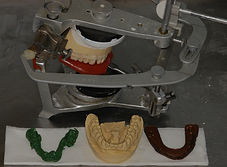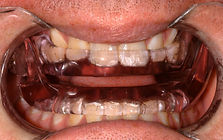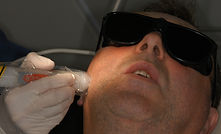
Dr Tim Lego
BDSc (HONS) Grad Dip Dental Sleep Medicine (UWA)
-
Snoring and Obstructive Sleep Apnoea
-
Sleep Bruxism and Temporomandibular Dysfunction
-
Interceptive Orthodontics
-
General Dental Care
"Member Australasian Sleep Association"
Sleep Disorders
Sleep Bruxism (teeth grinding and clenching)
Bruxism represents a ubiquitous yet normal condition that remains poorly recognised and unappreciated within medical and dental fields, with a reported prevalence of 14-20% in children and 8% in adults, males and females equally affected.
Bruxism (Brychien meaning grind in Greek) involves clenching and or grinding of teeth for non-functional reasons, having awake and sleep variants, each with differing aetiology, both centrally mediated.
Awake Bruxism (AB) is thought to be caused by anxiety, stress, anger and concentration, Sleep Bruxism (SB) defined as a sleep related movement disorder with a global aetiology including psychosocial, neurochemical and or sleep arousal inputs.
Sleep arousals represent transient reactivation of brain, heart and or respiratory activities with consequent rise in masticatory muscle activity often culminating in tooth contact (sleep bruxism), associated with a sudden change in depth of sleep where patients arrives in a lighter plane of sleep, with or without awakening.
Sleep Bruxism is often multifactorial in origin, namely;
-
Psychosocial – stress (AB >> SB)
-
Neurochemical - nicotine, caffeine, recreational drugs, medications, hormonal change / imbalance, alcohol, anemia
-
Sleep arousal – periodic limb movement, sleep disordered breathing, REM sleep behaviour disorder, night terrors, pain states, insomnia, GERD, circadian rhythm sleep disorders
-
Neurologic disorders - stroke, coma, dementia, trauma, syndromes, PTSD, epilepsy, movement disorders
-
Genetics (20-50%)
Some believe Sleep bruxism represents the body’s attempt at maintaining, restoring and or protecting the airway whilst asleep. In particular, conditions that predispose to sleep related mouth breathing, namely increased airway resistance (congestion, obesity), conditions that place the body under load (physical / psychosocial stressors, hormonal change / imbalance, pain), and or a interfere with oxygen carrying capacity of blood (anemia), will not only result in elevated levels of sleep bruxism, but may also potentially predispose patients to a myriad of related medical co-morbidities.
Due to increased force, duration and frequency of tooth contact, sleep bruxism is a common cause of dental and or Temporomandibular (TMD) complications, producing characteristic patterns of dental breakdown, more so in patients with a history of dental intervention and or fluoridation.
Management for sleep bruxism will vary according to both medical and dental status, and may include;
-
Referral for medical assessment (blood test)
-
ENT / Sleep assessment
-
Splint therapy
-
Biofeedback
-
Medications
-
Strengthening of weakened teeth / replacement of missing teeth to help better distribute force
-
Self-awareness
-
Regular dental reviews
Dr Lego has undergone postgraduate training in the field of Sleep Bruxism and works in close collaboration with medical and dental specialists in the field.



Sleep Disordered Breathing (Snoring and Obstructive Sleep Apnoea)
The 3rd International Classification of Sleep Disorders (ICSD) classifies Sleep Related Breathing Disorders into 5 categories namely;
-
Obstructive Sleep Apnoea Disorders
-
Central Sleep Apnoea Syndromes
-
Sleep Related Hypoventilation Disorders
-
Sleep Related Hypoxemia Disorder
-
Isolated Symptoms and Normal Variants (Primary Snoring, Groaning)
Further to appropriate medical referral and supported by diagnostic sleep study, Primary (habitual) Snoring, Upper Airways Resistance Syndrome (UARS) and Obstructive Sleep Apnoea Syndrome (OSAS) are conditions that can be managed with dedicated Oral Appliance Therapy (OAT).
“Primary Snoring” is a sound generated in the upper airway without episodes of complete (apnoea) or partial (hypopnoea) upper airway obstruction, respiratory effort related arousals (RERA’s) or hypoventilation during sleep. Often more of concern to the bed partner, snoring in this context is not associated with daytime somnolence (sleepiness), insomnia, cardiovascular or cerebrovascular events. A sleep study (PSG) is often required to rule out Obstructive Sleep Apnoea (OSA). Whilst adults can snore and not have sleep apnoea and have sleep apnoea and not snore, snoring in children is abnormal and typically associated with OSA.
In the absence of hypopnoeas and apnoeas, “UARS” represents periods of increased respiratory effort during sleep ending in arousal (RERA’s), without hypoventilation, commonly affecting premenopausal women and often associated with daytime fatigue, headaches, hypotension, snoring, cognitive deficit, ADHD, periodic limb movement during sleep (PLMS), anxiety and depression, personality change, decreased libido and Functional Somatic Syndrome (irritable bowel syndrome, fibromyalgia, orofacial pain, temporomandibular dysfunction, burning mouth syndrome, back pain and chronic fatigue).
Being the more common sleep related breathing disorder and affecting 2-4% of middle aged adults, “OSAS” is characterised by repetitive episodes of hypopnoeas and or apnoeas during sleep, hypoventilation and associated symptomatic comorbidity if not premature mortality. OSA results from a combination of inadequate or abnormal neuromuscular control and or anatomic narrowing of the upper airway. OSAS risk factors include obesity, nasopharyngeal restriction, craniofacial abnormalities, neuromuscular disease, hypothyroidism, sleep posture, tongue-tie, smoking, alcohol, sedatives, sleep deprivation, age, gender, genetics, ethnicity, menopause, ventilatory control instability and sleep stage.
Signs and symptoms include snoring, witnessed apnoeas, choking and gasping during sleep, nocturnal awakenings, non-refreshing sleep, excessive daytime somnolence, fatigue, insomnia, impaired cognition, concentration and memory, headaches, reflux (post nasal drip, excessive salivation, non-productive cough, dysphagia), mood and personality changes, anxiety and depression, PLMS, impaired quality of life, impaired relationships, workplace and motor vehicle accidents, cardiovascular disease (hypertension, coronary artery disease, atrial fibrillation, stroke, angina, congestive heart failure, myocardial infarction), reduced libido, impotence, nocturia or bed wetting, night sweats, type 2 diabetes, hypercholestrolemia, central obesity, increased risk of perioperative complications and arousal based parasomnias including confusional arousals, sleep walking, sleep terrors, sleep related eating disorder, nocturnal epilepsy and REM sleep behaviour disorder. OSAS represents a chronic disease demanding long-term management including behavioural therapy, continuous positive airway pressure (CPAP), oral appliance therapy (OAT - Mandibular Advancement Splints), surgery, other adjunctive measures and or combinations thereof.
Dr Lego has undergone postgraduate training in the field of oral appliance therapy for Sleep Disordered Breathing and works in close collaboration with medical and dental specialists in the field.




Temporomandibular Dysfunction (TMD)
Temporomandibular Dysfunction (TMD) is classified as a spectrum disorder, affecting muscles of mastication and / or Temporomandibular (jaw) joint(s). The Temporomandibular joint (TMJ) is one of the most complex and frequently used joints within the body, and unlike most other joints, cannot be easily rested. TMD is common with about 70% of the population affected at some time in their lives (F>M) although only 5% seek treatment. Most experts agree that there is no single best treatment for diagnosing or treating TMD, however conservative, non-surgical therapy is the right way to begin.
Surgery and other invasive treatments, such as injections, can create more problems and are best left as last resort. Most TMD’s are temporary, but can return without warning and deteriorate if not managed properly. TMD’s are often multifactorial having both physical and psychosocial origins and hence usually demand a multidisciplinary approach. Conservative measures are generally employed initially, with emphasis placed on reducing pain, joint locking and increasing the range of jaw opening. If unsuccessful, patients are referred for appropriate specialist reassement.
Dr Lego has undergone postgraduate training in the field of Temporomandibular Dysfunction and works in close collaboration with medical and dental specialists in the field.




